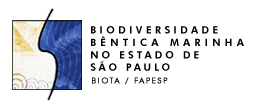The reduction of biodiversity at global scale is one of the great problems faced by humankind in the end of the millenium. To reverse the trend of extinction of species and environmental degradation it is necessary urgent, collective actions at local, regional and international levels, from the individual to the world’s governments, involving political and economic decisions. One fundamental step toward the maintenance of the integrity of the biosphere is the inventory of the global species diversity (Systematics Agenda 2000, 1994).Although the oceans cover most of the Earth’s surface and are fundamental sources of food, minerals and many other products for humans, their biota are very poorly known. At the same time all ocean systems are suffering a series of unprecedented stresses, which can alter drastically fish stocks, extinguish important species for biomedical products, impair water quality and the recreational and aesthetic value of marine environments (National Research Council, 1995).
The inadequate knowledge of the species present in marine communities – most of the marine species remain undescribed, and ecologically important groups of benthic and planktonic organisms are not considered in traditional estimates of biodiversity –, limits the understanding of ecosystem and how its function will be affected by human activities (National Research Council, 1995).The bottom biota, also known as benthos, is a highly diverse and complex group of organisms involved in the cycle of materials in the sea. Therefore, they play an important role on the energy flow from lower to upper levels in the trophic chains in marine and estuarine environments.Although the marine research in the State of São Paulo is one of the most developed in the country, most of its littoral environments are still poorly known, and there is not a comprehensive survey of its biota. The publications available deal exclusively with some specific taxa, in some environments only. If the intertidal and shallow zones of the rocky and sandy shores of some regions of the State are relatively known concerning the macrofauna, there is almost a complete void of knowledge in relation to the biota living below 5-10 m deep. Although the sandy beaches constitute one of the most extensive littoral environments of the Brazilian coast, few studies were made on its communities.
The same can be said about the meiofauna, on which there is a remarkable absence of studies in Brazil. Also, there is not a single species record of several phyla, like Mesozoa, Placozoa, and Loricifera, and many important ones, such as Nematoda and Copepoda, are almost completely neglected. There are therefore many taxa to be described or redescribed. This lack of information makes the evaluation of the biodiversity of the animal communities along the Brazilian coast very limited or even impossible, as well as the evaluation of environmental impacts of natural or anthropogenic origin.Even considering the basic nature of the present proposal, and the need for a qualitative evaluation of the study area, this project is not limited just to the systematic and distribution aspects. Rather than that, it makes way for the elaboration of several others on areas such as the morphology, cytogenetics, physiology, and ecology of marine invertebrates.
One aim to provide a better understanding of the relationships among the organisms and the environment. Besides, aspects of the reproductive biology can indicate periods of maturity for the different species living in the study area, including, for instance, those of commercial value.One has to consider, also, that the coast of the State of São Paulo is suffering a great amount of anthropogenic stresses, and studies on the biodiversity aspects could show how much that human action is interfering on the composition of this ecosystem’s biota. Taking into account the extension of the Brazilian coast and the scarcity of knowledge regarding the ecology and biology of the marine species it is undeniable the need to prepare qualified researchers to work with several animal groups and the several branches of biological sciences. This research proposal aims basically an integrated survey of the biota of one of the less studied regions of the State of São Paulo: the northern coast. In this segment the Serra do Mar is very close to the ocean, and the narrow coastal plain is interrupted by seaward extensions of the mountains, leaving lunate stretches of sandy beaches between rocky headlands. In some protected places mangrove forests develop. Most of this spatial diverse and complex environment is still well preserved, in great extent due to the presence of two protected areas.The main project is composed of four integrated subprojects:
1) rocky shore and associated algae,
2) sandy beaches – macrofauna,
3) non-consolidated sublittoral – macrofauna, and
4) meiofauna.
